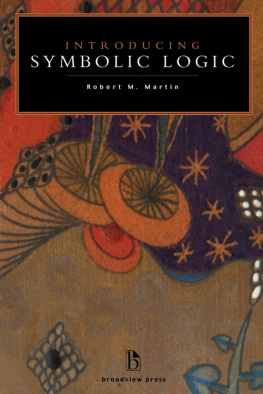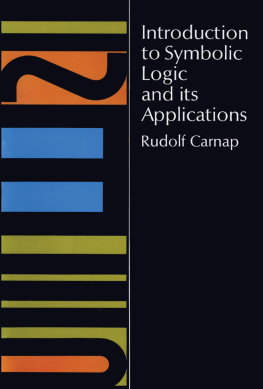The idea behind writing this was to produce a student-friendly logic text. Many students in the authors logic classes liked this idea enough to collaborate in the project by providing a long list of typos, unclarities, and flat-out mistakes in photocopied earlier versions of this book. The author apologizes to them for the earlier mess, and thanks them for providing so much help in cleaning it up. Special thanks in this regard are due to two A+ logic students, Dave Trennum and Sarah Brodbar-Nemzer. The collaboration with Broadview Press on this book began with a discussion between the author and Broadviews President, Don LePan, over (and abetted by) several glasses of Granite Brewery Peculiar Ale. Dons continuing sympathy with the authors unusual approach, and the helpfulness of the other nice folks at Broadview, are deeply appreciated.
INTRODUCTION
Youre about to enter the wacky and wonderful, thrilling world of Symbolic Logic!! It will change your life!!! It
No, no, no, stoppit! Thats easily recognizable stupid hype.
The truth is you can live without Symbolic Logic; but it can be interesting, fun, and somewhat useful. At least many students find that it is. Hope you do too.
Before we get down to business in , a few words about what Symbolic Logic is, what its good for, and what you should do when you read this book.
What Symbolic Logic Is
Very roughly speaking, Logic is the theory of good and bad reasoning. This book deals with Deductive Logic, which is one sort of reasoning. (In reasoning by providing general forms of good and bad reasoning using symbols. It looks a bit like algebra, or other kinds of symbol-using mathematics, as you can see if you take a quick glance at the rest of this book. But dont worry if you have math-phobia. You dont need to know any mathematics, or to have any skill at doing it, to learn Symbolic Logic.
What Its Good For
Logic textbooks sometimes claim that working your way through their book is a very good way to learn how to reason better. Thats probably a bit of an exaggeration. Finding out something about the theory of good and bad reasoning is not necessarily an effective way to improve your reasoning, any more than finding out about the physics of motion is a good way to improve your ability to catch a baseball. But there are, perhaps, some more modest practical payoffs to studying logic. It may make you a bit more sensitive to the logical ambiguities and mistakes involved in ordinary talk and reasoning. Or maybe not. Anyway, the real reasons for studying logic are the same as the real reasons for studying any sort of theory: it can be fascinating and fun. A lot of people just enjoy finding out how things work.
What You Should Do
Compared to most other textbooks, this one is not very long. Your reading assignments will be shorter than those in almost any other humanities class. But dont be misled by this into thinking that you can spend a lot less time on this. You cant just zip through it, the way you might rush through a novel. Youll have to read whats in here very slowly, and several times.
Do not plan to work on logic for long periods of time. After an hour or so your brain will simply refuse to do any more. Youll learn far more by doing six half-hour sessions than by attempting one three-hour session.
Always have pencil and paper handy when you read. Write down key concepts, in your own words. When samples of logical procedures are provided in the readings, try reproducing them yourself without looking at the text. Writing while reading is a far superior way to learn than just reading.
Youll find exercises scattered generously throughout this book. Its very important that you dont ignore these. You may sometimes feel that youve completely understood a section youve just read, so it would be a waste of time to do the exercises; but students have often found that this feeling is a mistake. Even though you seem to have understood the readings, you may still be unable to do the exercises. Being able to do the exercises is the true test of your grasp of the subject matter, so its an excellent way to find out how youre doing. If you have trouble with an exercise, you should go back and read the preceding section again, and maybe ask about the exercise in class. Even if the first exercises in a group seem easy, finish doing that group. Sometimes they get harder.
A second reason why the exercises are important is that doing them is essential for learning the material. An important part of learning Symbolic Logic is learning skills, not facts. Its more like learning how to ride a bicycle than like learning the capitals of the European countries. Its something you learn by trying to do it, by working your way from easier to harder tasks. Thats why the exercises are so important.
Answers are provided to all the exercises, but its extremely important that you consult them only after youve done your best to answer the questions on your own. Thats why the answer sections are a bit hard to find, separated from the questions, at the end of each chapterto discourage you from glancing at them when you try to do the exercises.
If you have trouble with some exercises, dont look up the answers right away. Go back and re-read the section preceding those exercises, and then try them again. Look at the answers only after youve tried hard to answer the questions, re-read the material, and tried again. This is the way to learn the subject matter. The way not to learn the subject matter is to look up the answers to the questions right away, after having given them no thought, or just a little.















